
 The newsletter of NASA's Radio JOVE Project
The newsletter of NASA's Radio JOVE Project"Planetary Radio Astronomy for Schools"

 The newsletter of NASA's Radio JOVE Project
The newsletter of NASA's Radio JOVE ProjectWelcome to the new Jupiter observing season (2002-2003 apparition). For this season we have created a new look to our Jupiter predictions tables. Not only do we think they are more easily readable, but we have expanded them to include many different time zones around the world.
Here is a sample of the new prediction table format:
PACIFIC TIME ZONE Date Day PDT UT Storm Hour Angle Antenna Phase Oct 16 Wed 0130 - 0530 0830 - 1230 Io-A/C -6.9 to -2.9 NS Antiphase Oct 17 Thu 0445 - 0645 1145 - 1345 Io-B -3.6 to -1.5 NS Antiphase Oct 23 Wed 0230 - 0615 0930 - 1315 Io-A/C -5.6 to -1.8 NS Antiphase Oct 25 Fri 0330 - 0515 1030 - 1215 Io-A -4.4 to -2.6 NS Antiphase
The URL for ALL of the Prediction Tables is:
http://radiojove.gsfc.nasa.gov/control/predictions.htm
Note that we have made a table for MOST time zones so you only have to look at your specific time zone for information. Each line in the table has the day of the week, the local time to observe the predicted Jupiter storm, and the type of storm. We also include the Universal Time for those who prefer it. In the last two columns we include the Hour Angle of Jupiter during the duration of the storm and the appropriate JOVE dual-dipole antenna phasing necessary to best observe the storm. (Dipole antenna phasing is described in Jim Thieman's "Technical Tip" in the March 2001 JOVE Bulletin http://radiojove.gsfc.nasa.gov/library/newsletters/2001Mar/2001Mar.txt). The Hour Angle is simple: it is the approximate location of Jupiter in the sky relative to your local meridian line (your meridian is the North-South line that divides the sky in half). We measure the Hour Angle from -6 hours (the object is rising) to +6 hours (the object is setting) with an Hour Angle equal to 0 when the object is on your meridian (also called transit). Some discussion on how to find your local meridian and transits can be found in the Radio JOVE Science Brief "Views from the Passenger Seat" at http://radiojove.gsfc.nasa.gov/library/sci_briefs/passenger_seat.htm .
This season we hope to have many more of you joining us to observe Jupiter with your own radio telescopes. Or perhaps you can join our live Jupiter data stream online via our permanent telescopes at the University of Florida and University of Hawaii-Windward Community College. Please see the Radio JOVE homepage or the end of this issue for links to these observatories.
We will also continue our coordinated observing sessions for the 2002/2003 observing season. These are a targeted list of Jupiter and solar radio storms with high probability of observing success. Observers can interact in several ways:
Please look for future emails and/or information on the Radio JOVE website about upcoming coordinated observing.
We hope you make some great observations this apparition! Best of luck this year, and may you have interference-free skies!
Since the beginning of the Radio JOVE project one of the important aspects of this effort has been communication between scientists, schools and individuals where observational results can be shared and questions can be answered. From the start we have encouraged the Radio JOVE teams to share their observational results with the other teams so we can confirm our results and possibly learn more about the objects we are observing. The primary means by which this has been done is via email. A disadvantage of this method is that sometimes the files attached to the email are large. Another disadvantage is that there may not always be enough information associated with these data to help us to understand what had been observed. An online archive has been in the works for a number of years where data can be freely shared and there is a uniform format to maximize the ability of everyone to understand the data presented.
We are happy to announce that this archive is now ready for use. Anyone can view the data already available as a tabular listing ordered by date or through a calendar interface. Nearly 200 observations of the Sun and Jupiter are already available spanning the years 2000 to the present. Most of the data is in the form of images but there are also several SkyPipe format data files, text files, and some sound files. Viewing and downloading of data from the archive is available to everyone. If you are interested in uploading data to the archive you must be a Radio JOVE team member or participating individual to get a username and password. You can request a username and password by sending email to rj_project@radiojove.gsfc.nasa.gov. No password is necessary to view or download the data.
The home page of the new JOVE archive is at http://jovearchive.gsfc.nasa.gov. There is still much work to be done and we hope to soon announce more features to this archive to make perusing the data more efficient and enjoyable. Many thanks go to the entire Radio JOVE core team for their dedication to this effort and their helpful suggestions. Thanks also go to our beta testing team of Jim Brown and John Thomas who provided the archive with many data files.
One of the most important aspects of the scientific process is making the results of your observations known to others, but it's often a step we neglect. In order to encourage Radio JOVE observers to submit their data to our central archive we offered to give away a calibrator to a team or individual chosen at random from among those who had submitted their data to the archive by April of this year.
A calibrator is a very useful addition to a Radio JOVE radio telescope since it allows the received signals to be compared to a standard source of radio noise. Using this comparison you can determine how strong the signal is from the distant target and, with some assumptions, make calculations of how much power is being emitted by this radio source. (See Lesson 7 in the Radio JOVE lesson plans for guidance in making these calculations). For those who don't have their own calibrator, the remote professional radio telescopes such as at Windward Community College and the University of Florida periodically include a "calibration sequence" in the signal they are sending out, usually about once per hour. The calibrator (RF2020S) was donated by Richard Flagg and is valued at $135.00. For more information about this calibrator you can contact him at rf@hawaii.rr.com.
In April we wrote out the names of all teams and individuals who had submitted data on pieces of paper and randomly picked one piece of paper. The result was a new calibrator for Brother Bernardin Marker and his students at the FGKRO (Franciscan Gymnasium Kreuzburg Radio Observatory) associated with Franziskanergymnasium Kreuzburg in GroC.krotzenburg, Germany. In the picture you can see the calibrator next to the Radio JOVE receiver being held by Brother Bernardin's students. You can read more about this Radio JOVE team in the March 2002 issue of the JOVE Bulletin.
We hope to have another calibrator giveaway in the future, but, regardless of prizes for submission, we hope you will send your results to our new archive so that all might benefit from the work you have done.
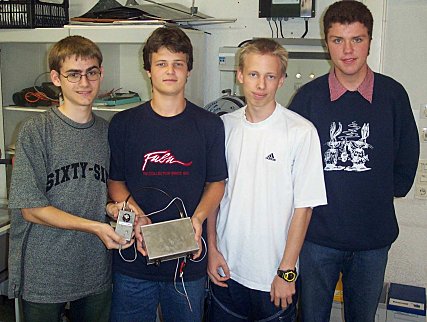 |
| The winners of the Radio JOVE Calibrator Giveaway |
There have been several adjustments made to the RJ Antenna Manual in order to make it more up to date with proper tools, assembly, and observing techniques. The antenna manual is available through new kit orders or from the Radio JOVE website at: http://radiojove.gsfc.nasa.gov/elab/rj_antennas.htm. The manual keeps the same layout as before but has been modified to include the addition of one section, Site Considerations, and the modification of 3 sections, Tools, Assembly, and Field Setup.
The Site Considerations section was implemented mainly for those who would like to setup their antenna on a rooftop (a possibility for a permanent setup). This section talks about some of the possible problems of having your antenna setup on a rooftop. If you want to increase the recommended lead cable length from antenna to receiver (for a receiver put indoors while antenna on rooftop or outside of building), this section informs you on how to calculate the appropriate length of cable for this purpose.
In the Tools section, there were updates made to the soldering iron recommendation to an iron with a higher heat output. Also, a soldering gun is recommended if higher soldering heat is needed. All models are available through Radio Shack. Note that if you already have a soldering iron or gun, try assembling the antenna with it, if you still need more heat then look at using either the soldering iron or gun mentioned in this section.
After having experience with a permanent Radio JOVE antenna that braved the outdoor elements, we have concluded that the center conductor in the cable is not as strong as expected. Thus, in the fourth step of the Assembly section, we have a warning indicating to be careful not to nick the center conductor.
The Field Setup section has been modified quite a bit. To make your antenna beam more sensitive to detect the observing object (either Jupiter or the Sun), a correct antenna phasing (orientation and polarity) must be used, which can be either In-Phase East-West, In-Phase North-South, Anti-Phase East-West, or Anti-Phase North-South. By using Radio Jupiter Pro software (www.radiosky.com), best phasing can be determined based on location and observing date. An additional note was added at the end of the Field Setup section indicating that an increased audio signal should be heard when hooking up the antenna to the receiver. Additional information on phasing can be found in Jim Thieman's Technical Tip in the March 2001 JOVE Bulletin at: http://radiojove.gsfc.nasa.gov/library/newsletters/2001Mar/2001Mar.txt.
All the changes made have refined and updated the antenna manual to complement the continued expansion of the Radio JOVE Project.
We have received several email reports from Radio JOVE participants about the observations they've made, problems and successes in building and operating the equipment and other news. We are always eager to hear from Radio JOVE participants whether through email or during one of our teleconferences or via SkyPipe chat. Please send us reports of the work you have been doing with Radio JOVE. We would love to hear from you!
We recently heard from Wendell Salmons AE4PD about life after retiring from Lexington Traditional Magnet School in Lexington, Kentucky. Besides traveling through New England and going on Caribbean cruises Wendell has made ham radio contacts with radio amateurs in all 50 states and every continent. He plans on using all the QSL cards he received through these radio contacts to teach geography and social studies to a class of fifth graders. Wendell is one of our first Radio JOVE participants and the video made by the local TV news of his class using their Radio JOVE equipment is available through the Radio JOVE website http://radiojove.gsfc.nasa.gov/vc/mm_exhibits.htm.
Harold Geller of the physics department at George Mason University has produced a series of pictures of the steps taken in the assembly of a Radio JOVE kit. These images are a great resource for any novice builders of the Radio JOVE kit. They are available on the web at http://physics.gmu.edu/~hgeller/RadioJove/.
George Lauffer DC1GEL of Pforzheim, Germany reports that he has completed his Radio JOVE kit and has established the Black Forest Radio Observatory (BFoRO Latitude: 48.875 N, Longitude: 8.693 E). He has successfully received several solar bursts at his observatory and is looking forward to participating with other Radio JOVE teams in the upcoming Jupiter observing season. George has worked with several other teams in Europe including Brother Bernardin Marker's team in Großkrotzenburg, Germany; Ruggero Ulivastro from Nice, France; and Hannes Mayer from Salzburg, Austria.
The Radio JOVE project benefited this summer from the assistance of two college students, LiLi Bueno and Jennifer White. LiLi is a computer science graduate student from New York City attending the College of Staten Island. Jennifer is now a senior in physics and mathematics at Ripon College in Ripon, Wisconsin.
LiLi worked on data analysis software to be used by students to analyze radio signals they receive from their radio telescopes. Often the signals received from Jupiter and the Sun are masked by local manmade or natural Earth-based radio interference. LiLi researched the use of smoothing algorithms to suppress the interference and bring out the natural signals in the data. She also developed a user interface to allow the student to display the data, choose the type of analysis to be done and then show the results. She hopes to continue this project as a part of her graduate work in the future.
Jennifer conducted research on solar data received by Radio JOVE and professional radio telescopes during the summer. Radio JOVE telescopes are able to receive Type II and III solar bursts. What do these bursts tell us about the dynamic nature of the Sun? Jennifer measured the rise and fall rates of the Type III emissions and compared this information to the location of the storms on the Sun and the anticipated directionality of the storms. She also measured the drift rates of the much rarer Type II solar bursts and compared Radio JOVE observations to those done by professional ground-based radio telescopes as well as satellite observations of the same storms. (see http://radiojove.gsfc.nasa.gov/library/rec_reading.htm for further information). She hopes to continue this project as part of her senior studies program at Ripon.
Both LiLi and Jennifer also helped build a new radio JOVE receiver, as well as assessing the noise levels of radio interference on the roofs of Building 26 at GSFC and the Maryland Science Center. The highlight of the summer was the trip to the National Radio Astronomy Observatory in Greenbank, West Virginia for the Society of Amateur Radio Astronomers (SARA) Meeting. Here they gave presentations on their work and helped present the latest results of the Radio JOVE project to the SARA members.
The Radio JOVE team is grateful for all the work done by our student assistants, looks forward to continued collaboration with them, and wishes them the best in their future careers.
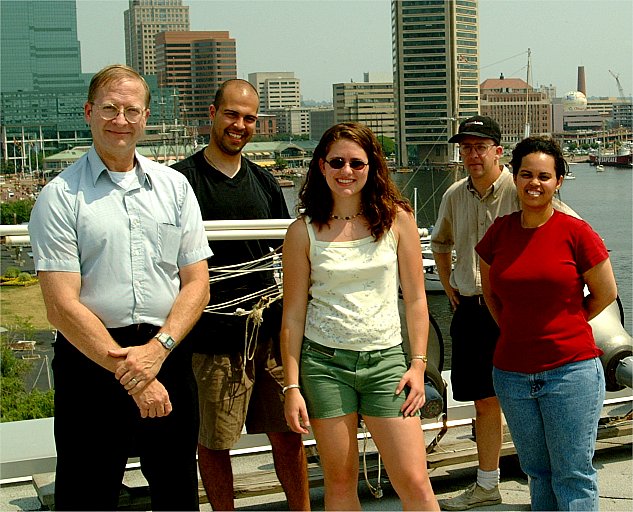 |
| Radio JOVE team members testing radio observing conditions on the roof of the Maryland Science Center(MSC), Baltimore, Maryland. Pictured from left to right are Jim Thieman, Albie Davison, Jennifer White, Brian Eney (MSC) and Lili Bueno |
Heliotown was an art exhibit, Heliotown is also the artist's Web site (http://www.heliotown.com). But for me, Heliotown is the observatory and studio of professional artist and amateur scientist, Tom Ashcraft. Tom has been an amateur radio astronomer for years, and was quick to join in Radio JOVE after the project began. He specializes in observing the Sun and Jupiter at decametric frequencies, so our project was a natural place for Ashcraft to share his observations with others.
This past June, Jim Thieman and I paid a visit to Tom at his observatory in Lamy, New Mexico, just South of Santa Fe. It was a Sunny afternoon - not uncommon here in Northern New Mexico. Each day, Ashcraft makes recordings of Solar radio activity and complements it with his own drawings of any sunspot groups visible with his 3-inch refractor. He closely monitors Solar activity reports from observatories in Europe and elsewhere to anticipate periods of intense activity.
 |
| Tom Ashcraft's New Mexico Studio and Observatory |
The setup at Heliotown is a collection of low dipoles cut for various frequencies that feed commercial shortwave receivers. Tom simultaneously captures his radio observations on paper chart recordings and digitized sound files. The receivers and chart recorders are housed in his outbuilding studio, but the audio is piped into the nearby house where his computers are located. His amateur science isn't a hobby for Ashcraft, but a significant part of his artistic explorations. As a result of his daily activities, he has amassed an impressive collection of data.
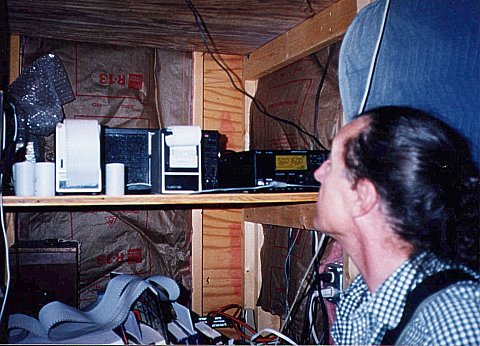 |
| Ashcraft recording observations |
Tom played us some audio recordings of Jupiter and pointed out the nuances in the playback. These were features of the chorus of Jovian and Galactic emissions that are lost in a simple amplitude chart.
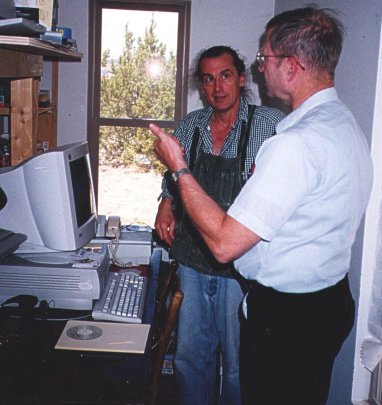 |
| Jim Thieman in Ashcraft's computer room |
Northern New Mexico has attracted many artists who come here to work and live. Some attribute that to the unique lighting here in the high desert. But it isn't the visible spectrum here that inspires Ashcraft, but the natural radio spectrum. Tom showed us examples of his art work in progress, and we spent some time talking of his approach to his work. Those few hours did not qualify me to relate his concepts and how he finds artistic expression in things normally considered the realm of science. Perhaps one day he will write an article for us to describe them himself.
It was good to finally meet Tom and to learn something of his work. He has since relocated to New York, pursuing his art there. Here's hoping that he's able to maintain his activities in radio astronomy. Heliotown is a part of the man and his work, after all, and not a point on a map.
Jim Sky and Dick Flagg are developing a new radio spectrograph which will greatly enhance the capabilities of the WCCRO and provide the Jove Program with a new look at signals from Jupiter and the Sun.
As you know, the Jove receiver operates at a single frequency in the vicinity of 20.1 MHz. The receiver can be tuned manually over a small range (300 kHz) to avoid station interference. When used with SkyPipe software you can display received signal strength as a function of time on your computer.
The heart of the new spectrograph is a special radio receiver that steps through 200 discrete frequencies, ten times each second. These 200 channels lie in the range of 18 to 28 MHz. The resulting display, called a spectrogram, depicts signal strength received in each of the 200 channels as a function of time. The horizontal axis of the spectrogram is time, the vertical axis is frequency, and the color or intensity of each pixel represents signal strength.
In July, we ran preliminary tests with the new spectrograph and were fortunate to catch some nice solar bursts. A spectrogram and a SkyPipe record both show this activity. On the spectrogram the solar bursts are seen as light colored areas against the darker background. There are also stations present which appear as white horizontal lines. It is easy to see the correlation between the Skypipe record obtained at 20.2 MHz and the wideband solar bursts on the spectrogram. Brighter areas on the spectrogram compare with stronger signals on the SkyPipe record.
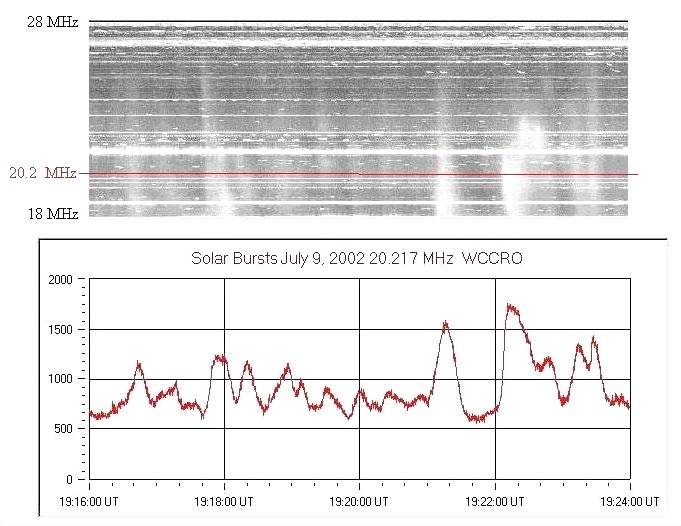 |
| A comparison of a solar burst on July 9, 2002 observed with the new WCCRO spectrogram (18-28 MHz) and Radio SkyPipe at 20.1 MHz |
We plan to have the new spectrograph on line for the upcoming Jupiter season. The spectrograph data will be available in real time via the Internet during many predicted Jupiter noise storms. Free software will be available to view the spectrograms. We will also be streaming a channel of SkyPipe data and audio from the Hawaii observatory - so please tune us in http://jupiter.wcc.hawaii.edu/.
Repairs of the TP antenna will be completed in time for the beginning of the Jupiter observing season which will start around the end of October. The replacement of two masts damaged by a wind storm was completed during the past summer as well as repairs of ropes and replacement of termination resistors. All the eight right hand and eight left hand circularly polarized TP's will be back in operation during the coming season.
In collaboration with Prof. Kazumasa Imai from the Kochi National College of Technology in Japan we plan to make up to 8 channels of the data collected from the TP array available live on a web site. The chart recorder display will show the amplitude as a function of Universal Time of the right and left hand polarized components of three frequency channels (18, 20, and 22 MHz) plus the 20.1 MHz Radio Jove channel. Screen refresh time between 3 to 60 seconds will be available. The user will be able to select the refresh time to fit the connection speed of his/her system. A preliminary test of the system was successfully performed during daytime on August 13 at UFRO, during Prof. Imai annual visit to the Univ. of Florida; a few solar bursts were detected during the test. The data will be acquired by a KARACRIX/IOB30RTA system. The web site will be located in Japan and managed by Prof. Imai and his collaborators. Netscape is recommended in order to see a smooth scrolling of the chart recorder.
As we did during last season, we will continue streaming the audio output from one of the TP channels during the hours of the Jupiter observation. The plan is to switch the audio streaming to the audio output of the INSPIRE receiver outside the Jupiter observing hours.
Targeted to the SkyPipe users we are also finalizing plans for streaming up to four frequency channels, both left and right circular polarization, of the TP data using Skypipe. All of these data streams and other information are available through the UFRO web site at http://ufro1.astro.ufl.edu/
This software may be download from the Radio JOVE software page http://radiojove.gsfc.nasa.gov/dal/software.htm.
The JOVE Bulletin is published several times a year. It is a free service of the Radio JOVE Project. We hope you will find it of value.
Back issues are available on the Radio JOVE Project Web site, http://radiojove.gsfc.nasa.gov/
For assistance or information send inquiries to: